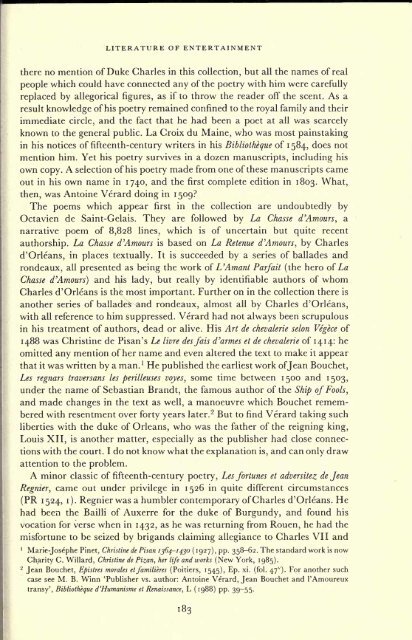Untitled - Monoskop
Untitled - Monoskop
Untitled - Monoskop
You also want an ePaper? Increase the reach of your titles
YUMPU automatically turns print PDFs into web optimized ePapers that Google loves.
LITERATURE OF ENTERTAINMENT<br />
there no mention of Duke Charles in this collection, but all the names of real<br />
people which could have connected any of the poetry with him were carefully<br />
replaced by allegorical figures, as if to throw the reader off the scent. As a<br />
result knowledge of his poetry remained confined to the royal family and their<br />
immediate circle, and the fact that he had been a poet at all was scarcely<br />
known to the general public. La Croix du Maine, who was most painstaking<br />
in his notices of fifteenth-century writers in his Bibliotheque of 1 584, does not<br />
mention him. Yet his poetry survives in a dozen manuscripts, including his<br />
own copy. A selection of his poetry made from one of these manuscripts came<br />
out in his own name in 1740, and the first complete edition in 1803. What,<br />
then, was Antoine Verard doing in 1509?<br />
The poems which appear first in the collection are undoubtedly by<br />
Octavien de Saint-Gelais. They are followed by La Chasse d'Amours, a<br />
narrative poem of 8,828 lines, which is of uncertain but quite recent<br />
authorship. La Chasse d'Amours is based on La Retenue d'Amours, by Charles<br />
d'Orleans, in places textually. It is succeeded by a series of ballades and<br />
rondeaux, all presented as being the work of L'Amant Parfait (the hero of La<br />
Chasse d'Amours} and his lady, but really by identifiable authors of whom<br />
Charles d'Orleans is the most important. Further on in the collection there is<br />
another series of ballades and rondeaux, almost all by Charles d'Orleans,<br />
with all reference to him suppressed. Verard had not always been scrupulous<br />
in his treatment of authors, dead or alive. His Art de chevalerie selon Vegece of<br />
1488 was Christine de Pisan's Le livre desfais d'armes et de chevalerie of 1414: he<br />
omitted any mention of her name and even altered the text to make it appear<br />
that it was written by a man. 1 He<br />
published the earliest work of Jean Bouchet,<br />
Les regnars traversans les perilleuses voyes, some time between 1500 and 1503,<br />
under the name of Sebastian Brandt, the famous author of the Ship of Fools,<br />
and made changes in the text as well, a manoeuvre which Bouchet remem-<br />
bered with resentment over forty years later. 2 But to find Verard taking such<br />
liberties with the duke of Orleans, who was the father of the reigning king,<br />
Louis XII, is another matter, especially as the publisher had close connections<br />
with the court. I do not know what the explanation is, and can only draw<br />
attention to the problem.<br />
A minor classic of fifteenth-century poetry, Les fortunes et adversitez de Jean<br />
Regnier, came out under privilege in 1526 in quite different circumstances<br />
(PR 1 524, i ) . Regnier was a humbler contemporary<br />
of Charles d'Orleans. He<br />
had been the Bailli of Auxerre for the duke of Burgundy, and found his<br />
vocation for verse when in 1432, as he was returning from Rouen, he had the<br />
misfortune to be seized by brigands claiming allegiance to Charles VII and<br />
1<br />
2<br />
Marie-Josephe Pinet, Christine de Pisan 1364-1430 (1927), pp. 358-62. The standard work is now<br />
Charity C. Willard, Christine de Pizan, her life and works (New York, 1985).<br />
Jean Bouchet, Epistres morales etfamilieres (Poitiers, 1545), Ep. xi. (fol. 47 V<br />
). For another such<br />
case see M. B. Winn 'Publisher vs. author: Antoine Verard, Jean Bouchet and 1'Amoureux<br />
transy', Bibliotheque d'Humanisme et Renaissance, L (1988) pp. 39-55.<br />
I8 3

















